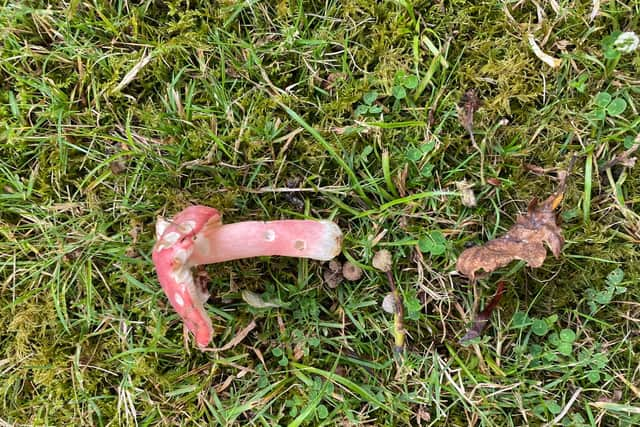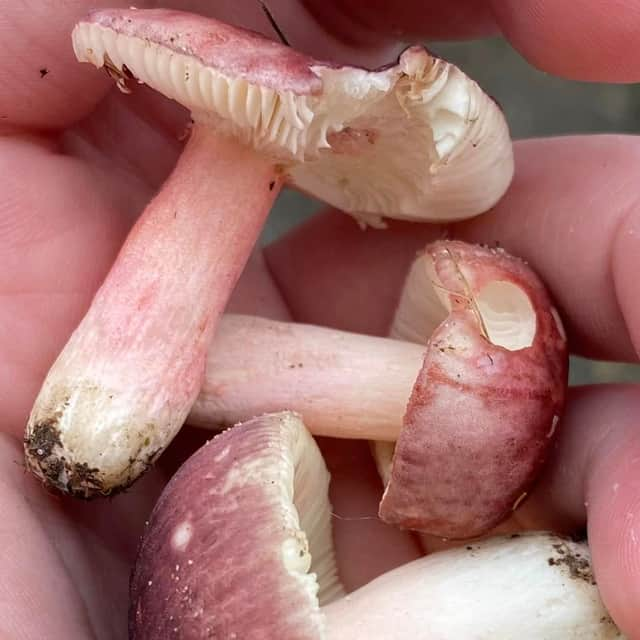'Brittlegills' mushroom: Fungus so rare it doesn’t have common name found in British Isles for first time
and live on Freeview channel 276
A pink mushroom so rare it doesn’t have a common name yet has been found for the first time ever in the British Isles, by a fungi-loving hobbyist.
Charlotte Shenkin, who lives in Jersey, recently unearthed the unusual find in the Channel Islands. After consulting with experts, it appears she has discovered Russula stenocystidiata - a rare mushroom which has been recorded in Southern Europe - growing in the British Isles for the first time.
Advertisement
Hide AdAdvertisement
Hide AdThe stay-at-home mum said she was a passionate citizen scientist, and she had been "on a high" since she found it. "If you’re a science geek then this is like Christmas came early," she told SWNS. "By a complex process of elimination I eventually ruled out all of the other possibilities and confirmed it as Russula stenocystidiata. The British expert confirmed there are no previous records in the British Isles.


Ms Shenkin continued: "My thoughts are the mushroom has possibly been in Jersey for a long time and either no one has ever noticed it, or they have but they didn't do the extra work to identify the particular species - it took me at least a month."
She first spied the "eye-catching pink mushroom" on a grass verge, as she was driving back from Jersey Zoo with her toddler last July. "After a sharp detour, I found myself looking at something that definitely felt unusual and possibly rare," she said.
She could tell the mushroom was in the 'Russula' genus - commonly known as Brittlegills - but said red and pink Russulas were notoriously difficult to tell apart. Ms Shenkin explained: "To identify Russulas you have to do quite a few standard tests; things like what they smell like, do they bruise a different colour, what colour are the spores, using a microscope to look at the shape of the spores."
Advertisement
Hide AdAdvertisement
Hide Ad

After she completed her tests, she posted about what she had found on a specialist mycology Facebook group, exciting experts from Britain, to Italy and the Netherlands. They also helped her to complete chemical tests - and look for specialised cells under her microscope.
After confirming the species, Ms Shenkin sent the dried samples and all of her data to the Kew Gardens Fungarium and the Surrey Fungus Study Group, who will catalogue it. With the mycologists' help, she said, "we managed to prove this new record for the British Isles without doubt".
The mushroom enthusiast's interest in fungi only began in October 2022, but she said her previous science background - as a teacher, reptile zookeeper, and lab technician - "definitely helped". "I’ve always been interested in nature, finding and identifying things," she said, attributing her strong pattern recognition ability and capacity to absorb scientific knowledge to her autism and ADHD.
"I’m passionate about mushrooms because they are both fascinating and absolutely everywhere once you start looking," she added. "It’s like a treasure hunt but the treasures are everywhere all year round, you just have to look and suddenly you find something exciting and new to learn about".
Advertisement
Hide AdAdvertisement
Hide AdThe unusual Russula is not Britain's only unusual fungal discovery in recent months. A spectacular type of fungus so rare it was once thought to have gone extinct in the UK was spotted in Kent in November, by experts on a mushroom hunt.
The candelabra coral - also known as crown-tipped coral fungus due to the crown-like shape of its ‘branches’ - was found in the Kent village of Addington by ecologist Rhianna Dix while on a fungal foray. This was only the third time it has been found in the UK after more than a century without a sighting, but it is found more frequently in North America - where it usually grows on decaying wood.
Comment Guidelines
National World encourages reader discussion on our stories. User feedback, insights and back-and-forth exchanges add a rich layer of context to reporting. Please review our Community Guidelines before commenting.
